City Quarters of Singapore

The modern Singapore is not only known for its economic success, the impressive skyscrapers and shopping-malls, but it also shows its traditional roots in the city quarters Little India, Chinatown and Arab Street. Once released for demolition, the city quarters with their historical buildings and shophouses offer a compensation to the skyscrapers in the Central Business District and provide a cozy atmosphere.
The city quarters were restored in the 19th century and they invite for rambling, eating and drinking and specially for getting introduced into the different cultures. The exploration of the city quarters definitely belongs to the highlights of Singapore, as one can practically dive every day into completely different worlds.
Little India
The big main road Serangoon Road is the centre of the quarter, there, taylors, fruit and vegetable shops, clothing shops, electronic goods shops and small shops that sell hotchpotchs string together. Mainly people of Indian origin live here, but also foreign workers from Bangladesh, Sri Lanka and other parts of India.
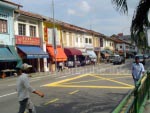
The crowd is specially big on sundays, as then the workers have their free day and mee outside for having a talk, eating and drinking. If one wants to feel really like being in India, this day is he right one. But one should consider to be dressed in an appropriate way despite of the heat. In order to respect the people, as a woman one should cover the knees and the shoulders and avoid plunging necklines.
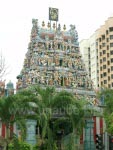
On sundays there are mainly only men on the street and white skin is still the ideal of beauty and there are one or two foreign workers who never saw a white woman. This is why one should not be surprised if the men stare at one like to an animal in the zoo. Those who prefer less hype will be better off in a week day for the exploring tour. The women in the colourful saris, the men in their traditional robes with turbans and the sweetish scent of incense displace one into a different world.
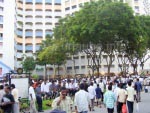
The easiest way to get to Little India is with the MRT up to the same named station and walking alongside the Serangoon Road in northern direction up to the Lavender Street. In less than 10 minutes one gets to the Kali Amman Temple. This temple is one of the oldest and most beautiful Indian temples. It was arranged in the year 1881 by Bengalian workers and is dedicated to the goddess Kali, one of the wifes of Shiva. She is the goddess of the power and the name Veeramakaliamman means "Kali the brave".
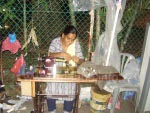
One should take off the shoes before entering, as this is the only way to view the interior of hindoo temples and mosques. Being lucky, one can even experience a mass. The ceremonies that are usually emphasized with music, songs and dances, most of the times take place on bank holidays (see table of bank holidays). But it is appropriate to remain in the background so that one does not disturb the local people during their celebrations. Moreover, it is not possible to take pictures in all temples, but this is indicated in signpostings; Nevertheless, one does not have to be afraid as the people are used to the tourists and accept them in a very friendly but reserved way. One can admire all kinds of hindoo goods and the meticulously elaborated statues, that are abundantly granted with sacrificial offerings in form of fruits, beverages, floral wreaths and incense sticks.
By walking the Serangoon Road further upwards one gets to the notorious Mustafa Center (Serangoon Plaza). In this department store one can get almost everything from jewelry, electronic goods, clothing up to food. Here, the prices are considerably lower than in the rest of Singapore.
The special thing of this department store is that it is opened 24 hours at seven days per week. But one is strictly checked up at the entrance and has to leave there the rucksacks, bags or shopping bags. By this way, the security staff tries to avoid theft and therewith this is purely a protection for the department store.
Chinatown
Chinatown is the place where the trading started with a variety of goods. Here, one finds well kept shophouses and buildings in Chinese style that are painted with Chinese characters and framed by numerous red lamps. The building form of these houses is oftenly also called Chinese baroque, as classical elements from Italy or corinthian columns were elaborated with Chinese tradition; Everywhere in and at the shophouses there are Chinese symbols of fortune that reject bad spirits and are supposed to keep the happyness and richness of the inhabitants.
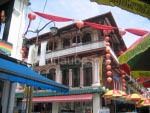
A walk through Chinatown is not only worthwhile because of the special arquitecture but also due to the temples, vivid market life and the good food. It is easy to get to Chinatown with the MRT and from there explore everything by foot. Right at the MRT Station there are also the shopping centres People's Park nd Chinatown Point, they are not as modern as for example Suntec City (see our chapter Shopping). But nevertheless, they are worthwhile to visit, as nowhere else there are as opposite selling stands as there.
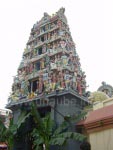
Beside the cookshop there is also the shoe selling or the permanent make-up tightly side by side. In the upper floors, there is everything available concerning cosmetics and beauty. Here, not only the tourists get massaged but also the local people. The same applies to the cosmetic facial treatment and foot care. Compared to European prices, all offers are cheaper, but nevertheless, one should not forget to negotiate (a back massage costs approximately S$20 for one hour, an hour of facial treatment approximately S$ 40). Typically is that between the shophouses the repeatedely rising HDB residential houses in Chinatown.
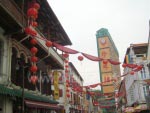
The apparently oldest and most important hindoo temple in Singapore is the Sri Mariamman Temple in the South Bridge Road. This temple was first built in the 1827 of wood and replaced in the year 1843 by a stone building. In the year 1973 it has been declared to a national monument of Singapore. It is dedicated to the godess Mariamman, a godhood that was specially adored for help during plagues like cholera or pox.
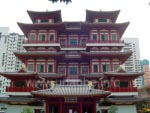
New figures, carvings and elements are repeatedely added and adorn the temple. Only the portal at the entrance invites to a permanent admiration of the numerous gods. Still today, weddings and other festivities are celebrated here with music and dance.
Another temple is the Kwan Im Tong Hood Che Temple. This top modern 5-floored buddhist temple is even equipped with a lift. Beside different buddha statues of real gold there are also urn-shaped vases, sacrificial alters and a museum. Even though this temple cannot compete with its interior design with the older temples, there is brisk business. If one wants to experience a totally opposite way of religiousness is exactly at the right place. Monks with a laptop receive one at the reception area and also LCD flat screens are placed as means of advertisement for donations.
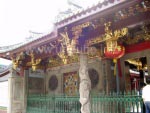
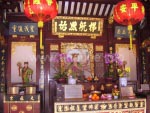
A further worthwhile seeing temple is located at the Amoy Street, the Siang Cho Keong Temple. This Taoist temple was built in the year 1869 by the Hokkiens, the biggest and most successful Chinese population group of Singapore.
The market in Chinatown invites for shopping during the whole day up to approximtely 09.00 p.m., specially souvenirs can be obtained for cheap money. From taylors, cloth shops, electronic goods shops, everything is available here.The pashmina-scarves are very popular, not only as an ideal souvenir for the ones at home but also very adequate for wearing in Singapore, as the MRT and also the department stores are very strongly air-conditioned.
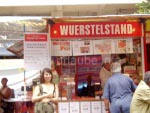
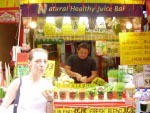
A curious thing as that in Chinatown there is also a sausage stand that is carried on by n Austrian: Erich's sausage stand; With the advertising slogan to be the last sausage stand before the equator, he does not only sells his snacks to the tourists and long ago it became an institution. Not only his offer of food transmits a piece of home country but also the little chat for which the business man still takes the time; Right beside the stand there is a juice bar that offers the best freshly squeezed juices from the most exotic fruits - at unbeatable prices (from S$1,50). One should also try in any case the specially good tasting small Thai-coconuts!
Arab Street and Sultan Mosque
Not only Chinese and Malays belonged to the former trade partners of Singapore but also the Arabs. The quarter of the Arab Street is influenced by the islam and is located beween the Jalan Sultan and Rochor Road at the north and south and the Jalan Besar and Beach Road in the west and east very close to the Bugis The food is highly recommendable, as there are numerous locals and small restaurants that offer national food. The prices can differ a lot and are between S$ 4 and S$ 30, but compared to Europe still cheap.
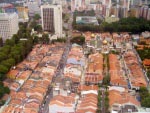
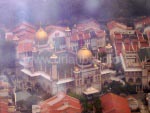
Beside food offers there are also a lot of small shops that offer all kinds of cloths, carpets and art crafts. The Sultan Mosque, that impresses just by its bigness, forms the centre of the Arab Street. The mosque was not finished until the year 1928 and accomodates the biggest praying hall of the city. One can also get into the mosque, thereby one should consider the praying times, as during these times the entrance is forbidden.

Back to the index Singapur
Author: Natascha Nißl; Copyright: Patrick Wagner, www.tourist-guide.biz
|